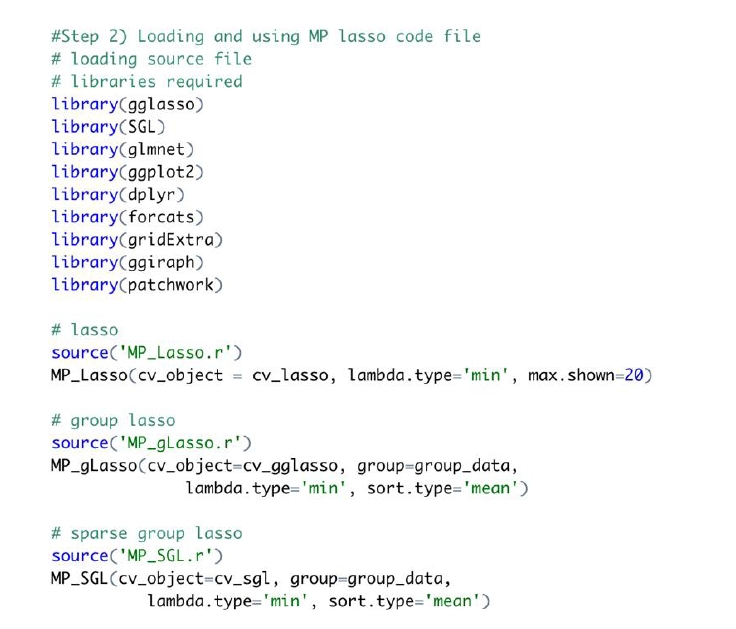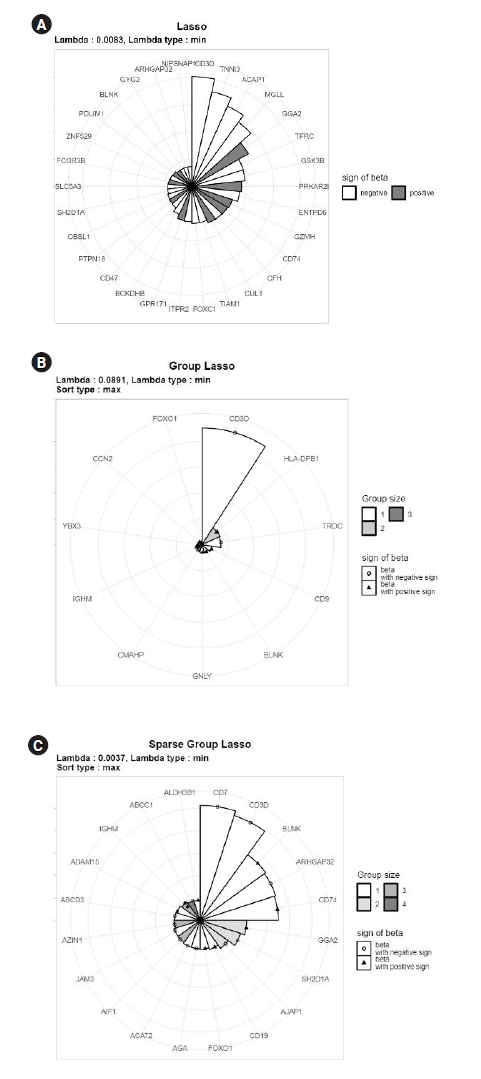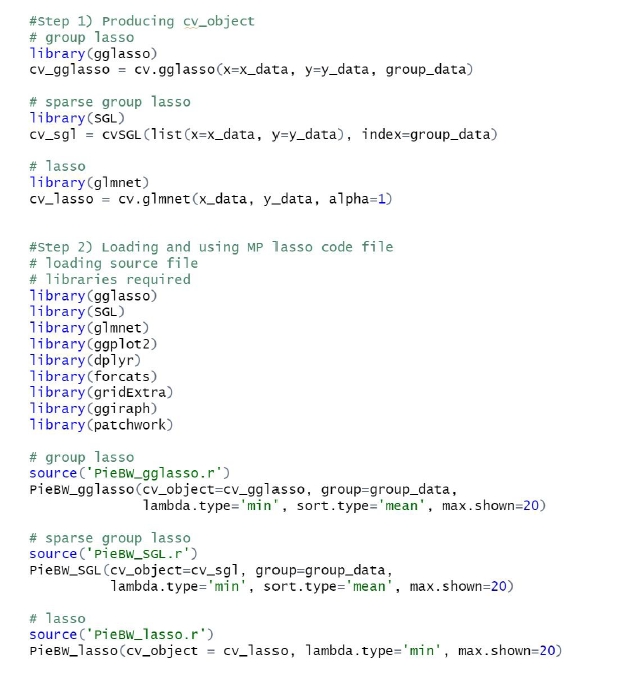 |
 |
- Search
| Genomics Inform > Volume 20(4); 2022 > Article |
|
Abstract
Penalized regression has been widely used in genome-wide association studies for joint analyses to find genetic associations. Among penalized regression models, the least absolute shrinkage and selection operator (Lasso) method effectively removes some coefficients from the model by shrinking them to zero. To handle group structures, such as genes and pathways, several modified Lasso penalties have been proposed, including group Lasso and sparse group Lasso. Group Lasso ensures sparsity at the level of pre-defined groups, eliminating unimportant groups. Sparse group Lasso performs group selection as in group Lasso, but also performs individual selection as in Lasso. While these sparse methods are useful in high-dimensional genetic studies, interpreting the results with many groups and coefficients is not straightforward. Lasso's results are often expressed as trace plots of regression coefficients. However, few studies have explored the systematic visualization of group information. In this study, we propose a multi-level polar Lasso (MP-Lasso) chart, which can effectively represent the results from group Lasso and sparse group Lasso analyses. An R package to draw MP-Lasso charts was developed. Through a real-world genetic data application, we demonstrated that our MP-Lasso chart package effectively visualizes the results of Lasso, group Lasso, and sparse group Lasso.
In the analysis of high-dimensional genomics data, the least absolute shrinkage and selection operator (Lasso) method and its variants have been widely used to perform regression and model selection [1-3]. Typical Lasso performs variable selection at the individual gene level. However, genomic data can have a group structure, as in gene-expression data with pathways or in single-nucleotide polymorphism (SNP) data with genetic regions including multiple SNPs from genome-wide association studies. Better predictions can be expected if the group structure of the genes is considered. Several variants of Lasso have been developed to address the group structure [4-7]. Group Lasso ensures sparsity at the level of pre-defined groups and eliminates unimportant groups [4]. Moreover, sparse group Lasso combines Lasso and group Lasso to enable group selection as well as individual selection [5].
Visualization is used to effectively summarize the results of high-dimensional data analysis. The results of Lasso are often expressed as a tracking plot of regression coefficients. However, few studies have explored the systematic visualization of group information. In this study, we propose a multi-level polar chart for visualizing group Lasso analysis (the MP-Lasso chart). The MP-Lasso chart is an improved version of the MP chart, which was originally developed for integrating results from multi-omics data analyses [8]. An MP-Lasso chart shows at a glance the variables selected for each variable group and their coefficient estimates produced by group-structured penalized methods. We developed a program for creating MP-Lasso charts called ŌĆ£MP-LassoŌĆØ using R (https://github.com/statpark/MP-Lasso).
Consider a general linear model. We have n observations, and the data consist of n├Ś1 including the response variable y and a n├Śp matrix X of predictors. Assume that y and X have been centered. The objective function of Lasso is
where ╬╗ is a tuning parameter, ||ŌłÖ||1 stands for the vector l1-norm and ||ŌłÖ||2 stands for the vector l2-norm. This penalty shrinks any coefficients contributing to the minimization problem to 0 [1].
Suppose that the predictors consist of G groups. Let Xg be a matrix for the predictors of the gth group with the corresponding coefficient vector ╬▓g. The objective function of group Lasso is
where p g
Sparse group Lasso uses a more general penalty to generate sparsity at both the group and individual feature levels, allowing the selection of groups and within-group variables. The objective function of sparse group Lasso is given by
where ╬▒Ōłł[0,1] and ╬▓=(╬▓1,ŌĆ”,╬▓G) [5,9]. ╬▒ is a convex combination of Lasso and group Lasso. This criterion is equivalent to group Lasso if ╬▒=0, and to Lasso if ╬▒=1.
An MP-Lasso chart consists of an outer level and an inner level. The outer level shows the overall impact of each group, and the inner level represents the impact of each variable within a group. For the outer level, the circle is divided into as many sectors as the number of groups. The segments in the chart are sorted by the maximum value of the coefficients in each group. A group with a rank of 1 starts at 0┬░. The radius of each sector is set to be proportional to the maximum value of the coefficients. When sorting or determining the radius, the maximum value may be replaced by the average. The number of variables in each group can be distinguished by the color of each segment.
For the inner level, points representing the variables in each group are plotted in each segment. The location of variables within each group is scaled by dividing the coefficient by the radius of the sector to represent the relative size. Different symbols are used according to the sign of the coefficient, and the number of variables belonging to each group is represented by the color spectrum.
Each point is jittered slightly to avoid overlapping. Scatter plots are depicted in an interactive manner; moving the cursor on a point shows information about the variable. Fig. 1 shows an example of an MP-Lasso chart using results from group Lasso analysis with eight groups. Group 4 has the variables with the largest coefficients, followed by group 2, and so on. Group 2 contains four SNPs, among which the SNP with the largest regression coefficient is V5, with a regression coefficient of 13.9773.
We developed an R package to draw MP-Lasso charts. The program is available online (https://github.com/statpark/MP-Lasso). The MP-Lasso chart program requires two inputs: a cross-validated (CV) object and a group vector. A CV object can be obtained from the output objects of R packages, such as glmnet [10], gglasso [11], and SGL [12]. Cv.glmnet in glmnet, cv.ggLasso in ggLasso, and cvSGL in SGL perform Lasso, group Lasso, and sparse group Lasso analyses, respectively. The output objects contain regression coefficients with respect to sequential and optimal ╬╗ values that minimize CV error. The group vector represents the group structure of variables. Group names should be in character type or integer type. The group vector should be identical to the one used when the CV object is created. MP-Lasso chart supports three methods: Lasso, group Lasso, and sparse group Lasso. Table 1 summarizes the functions of the developed package for MP-Lasso charts and related packages to obtain input data.
Fig. 2 shows an example of code to obtain a CV object from the data. The group Lasso and sparse group Lasso methods require three inputs: predictor variables (x_data), dependent variables (y_data) and group vector data (group_data). The user can choose the number of folds k. It should be noted that the cvSGL function for sparse group Lasso takes input in list type only. For the Lasso model, ╬▒ is set to 1 in the cv.glmnet function.
An example of code for an MP-Lasso chart is shown in Fig. 3. The required libraries should be loaded before using the MP-Lasso R code. The function is required to match the Lasso method that creates the CV object. The same group vector used to create a CV object is also taken as input.
MP-Lasso chart has three options to determine the details of a plot. The lambda.type option decides which ╬╗ to use for each method, and it can take two values (ŌĆ£minŌĆØ and ŌĆ£1seŌĆØ), with ŌĆ£minŌĆØ as default. The ŌĆ£minŌĆØ option chooses the ╬╗ value that minimizes the CV loss. The ŌĆ£1seŌĆØ chooses the largest ╬╗ with a CV error not 1 standard error further from the minimum CV loss. The ŌĆ£1seŌĆØ option chooses fewer variables. The sort.type option determines which numeric feature represents the coefficients of variables in each group. Two choices are available for the sort.type option, ŌĆ£maxŌĆØ and ŌĆ£mean.ŌĆØ The ŌĆ£maxŌĆØ option uses the maximum absolute coefficient in each group as the feature of the group, while the ŌĆ£meanŌĆØ option uses the mean of the absolute coefficients in each group. The last option is the max.shown option. When the number of chosen group is large, the chart can be too crowded with segments, making the chart difficult to interpret. By choosing max.shown, the user can decide the maximum number of segments shown on the chart. In the resulting MP-Lasso chart, interactive features are used. Moving the cursor over a point in the inner level displays information about that variable. For Lasso, moving the mouse over the sector area displays the corresponding information.
To illustrate the proposed MP-Lasso charts, we used T-cell and B-cell acute lymphocytic leukemia (ALL) data from the Ritz Laboratory [13]. The data consisted of microarray assays for 11,683 genes with 8,776 groups from 128 individuals with B-cell or T-cell ALL (https://bioconductor.org/packages/release/data/experiment/html/ALL.html). We conducted Lasso, group Lasso, and sparse group Lasso analysis for a binary phenotype using the glmnet, gglasso, and SGL packages. Each method is depicted using the ╬╗ value that yields the minimum 10-fold CV loss, and each group is represented by maximum absolute coefficients. For Lasso analysis, we set max.shown=30 for better representation. A summary of the results is presented in Table 2.
Fig. 4 shows the resulting MP-Lasso chart sorted by maximum coefficients. Without group information, the Lasso analysis in Fig. 4A shows variables with the largest coefficients. The variables in the CD3D, TNNI3, and ACAP1 groups had the largest coefficients, in descending order. For group Lasso in Fig. 4B, the CD3D group had much larger maximum coefficients than the other groups and the next two groups (HLA-DPB1 and TRDC) had similar maximum coefficients to each other. Two variables in the HLA-DPB1 group had very similar coefficient values, which can be read from the position of points in the HLA-DPB1 sector. Fig. 4C shows the results from sparse group Lasso. Unlike in group Lasso, no single group dominated, and several significant groups remained. It can also be read that the first two groups had similar maximum coefficients. In this example, each group contained a small number of features. However, even if there are many variables in the groups, the color spectra are automatically adjusted so that the number of groups can be distinguished. Therefore, the user can recognize that a brighter segment indicates a smaller group, while a darker segment corresponds to a larger group. In conclusion, an MP-Lasso chart illustrates the different choices of groups and variables made by each model in detail.
We proposed a simple and efficient graph called an MP-Lasso chart for visualizing results from a group-penalized model. We also developed a corresponding R package. An MP-Lasso chart provides a clear representation of each groupŌĆÖs information and the relative importance of each variable within a group. Using our package, one can identify important groups and variables at a glance without having to check tables containing thousands of coefficients. It also facilitates model interpretation and comparisons of multiple models.
Notes
Acknowledgments
This research was supported by a National Research Foundation of Korea (NRF) grant funded by the Korean government (MSIT) (NRF-2021R1A2C1007788).
Fig.┬Ā1.
Example of multi-level polar least absolute shrinkage and selection operator (Lasso) chart using group Lasso analysis.

Fig.┬Ā3.
Example R code for multi-level polar least absolute shrinkage and selection operator chart.

Fig.┬Ā4.
Multi-level polar least absolute shrinkage and selection operator (Lasso) chart for Lasso (A), group Lasso (C), and sparse group Lasso analysis of acute lymphocytic leukemia data.

Table┬Ā1.
R packages and functions for MP-Lasso charts
| Method | MP-Lasso chart function |
Related package |
|
|---|---|---|---|
| Package | CV object function | ||
| Lasso | MP_Lasso() | glmnet | cv.glmnet() |
| Group Lasso | MP_gLasso() | ggLasso | cv.ggLasso() |
| Sparse group Lasso | MP_SGL() | SGL | cvSGL() |
Table┬Ā2.
Top three groups with the highest maximum absolute coefficients
References
1. Tibshirani R. Regression shrinkage and selection via the Lasso. J R Stat Soc Series B Methodol 1996;58:267ŌĆō288.


2. Wu TT, Chen YF, Hastie T, Sobel E, Lange K. Genome-wide association analysis by lasso penalized logistic regression. Bioinformatics 2009;25:714ŌĆō721.



3. Ogutu JO, Piepho HP. Regularized group regression methods for genomic prediction: Bridge, MCP, SCAD, group bridge, group lasso, sparse group lasso, group MCP and group SCAD. BMC Proc 2014;8:S7.


4. Yuan M, Lin Y. Model selection and estimation in regression with grouped variables. J R Stat Soc Series B Stat Methodol 2006;68:49ŌĆō67.

5. Simon N, Friedman J, Hastie T, Tibshirani R. A sparse-group lasso. J Comput Graph Stat 2013;22:231ŌĆō245.

6. Zhao P, Rocha G, Yu B. The composite absolute penalties family for grouped and hierarchical variable selection. Ann Stat 2009;37:3468ŌĆō3497.

8. Park M, Kim D, Moon K, Park T. Integrative analysis of multi-omics data based on blockwise sparse principal components. Int J Mol Sci 2020;21:8202.



9. Friedman J, Hastie T, Tibshirani R. A note on the group lasso and a sparse group lasso. Preprint at https://doi.org/10.48550/arXiv.1001.0736 (2010).

10. Friedman J, Hastie T, Tibshirani R. Regularization paths for generalized linear models via coordinate descent. J Stat Softw 2010;33:1ŌĆō22.



11. Yang Y, Zou H. Package ŌĆśgglassoŌĆÖ: group lasso penalized learning using a unified BMD algorithm. Vienna: R Project for Statistical Computing, 2020.
12. Simon F, Friedman J, Hastie T, Tibshirani R. Package ŌĆśSGLŌĆÖ: fit a GLM (or Cox Model) with a combination of lasso and group lasso regularization. R package version 1.3. Vienna: R Project for Statistical Computing, 2019.
13. Li X. ALL: a data package. Vienna: R Project for Statistical Computing, 2022.
- TOOLS
- Related articles in GNI









